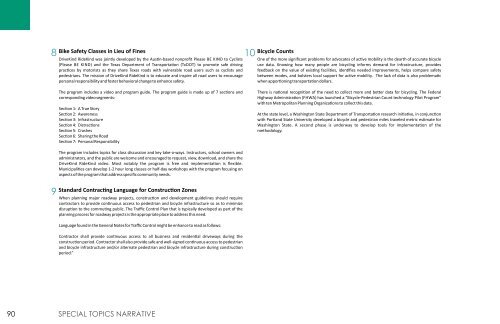Phase 1 Bike Plan_r
You also want an ePaper? Increase the reach of your titles
YUMPU automatically turns print PDFs into web optimized ePapers that Google loves.
8<br />
<strong>Bike</strong> Safety Classes in Lieu of Fines<br />
10<br />
Bicycle Counts<br />
DriveKind RideKind was jointly developed by the Aus n-based nonprofit Please BE KIND to Cyclists<br />
(Please BE KIND) and the Texas Department of Transporta on (TxDOT) to promote safe driving<br />
prac ces by motorists as they share Texas roads with vulnerable road users such as cyclists and<br />
pedestrians. The mission of DriveKind RideKind is to educate and inspire all road users to encourage<br />
personal responsibility and foster behavioral change to enhance safety.<br />
One of the more significant problems for advocates of ac ve mobility is the dearth of accurate bicycle<br />
use data. Knowing how many people are bicycling informs demand for infrastructure, provides<br />
feedback on the value of exis ng facili es, iden fies needed improvements, helps compare safety<br />
between modes, and bolsters local support for ac ve mobility. The lack of data is also problema c<br />
when appor oning transporta on dollars.<br />
The program includes a video and program guide. The program guide is made up of 7 sec ons and<br />
corresponding video segments:<br />
Sec on 1: A True Story<br />
Sec on 2: Awareness<br />
Sec on 3: Infrastructure<br />
Sec on 4: Distrac ons<br />
Sec on 5: Crashes<br />
Sec on 6: Sharing the Road<br />
Sec on 7: Personal Responsibility<br />
There is na onal recogni on of the need to collect more and be er data for bicycling. The Federal<br />
Highway Administra on (FHWA) has launched a “Bicycle-Pedestrian Count technology Pilot Program”<br />
with ten Metropolitan <strong>Plan</strong>ning Organiza ons to collect this data.<br />
At the state level, a Washington State Department of Transporta on research ini a ve, in conjunc on<br />
with Portland State University developed a bicycle and pedestrian miles traveled metric es mate for<br />
Washington State. A second phase is underway to develop tools for implementa on of the<br />
methodology.<br />
The program includes topics for class discussion and key take-a-ways. Instructors, school owners and<br />
administrators, and the public are welcome and encouraged to request, view, download, and share the<br />
DriveKind RideKind video. Most notably the program is free and implementa on is flexible.<br />
Municipali es can develop 1-2 hour long classes or half-day workshops with the program focusing on<br />
aspects of the program that address specific community needs.<br />
9<br />
Standard Contrac ng Language for Construc on Zones<br />
When planning major roadway projects, construc on and development guidelines should require<br />
contractors to provide con nuous access to pedestrian and bicycle infrastructure so as to minimize<br />
disrup on to the commu ng public. The Traffic Control <strong>Plan</strong> that is typically developed as part of the<br />
planning process for roadway projects is the appropriate place to address this need.<br />
Language found in the General Notes for Traffic Control might be enhance to read as follows:<br />
Contractor shall provide con nuous access to all business and residen al driveways during the<br />
construc on period. Contractor shall also provide safe and well-signed con nuous access to pedestrian<br />
and bicycle infrastructure and/or alternate pedestrian and bicycle infrastructure during construc on<br />
period.”<br />
90 SPECIAL TOPICS NARRATIVE


